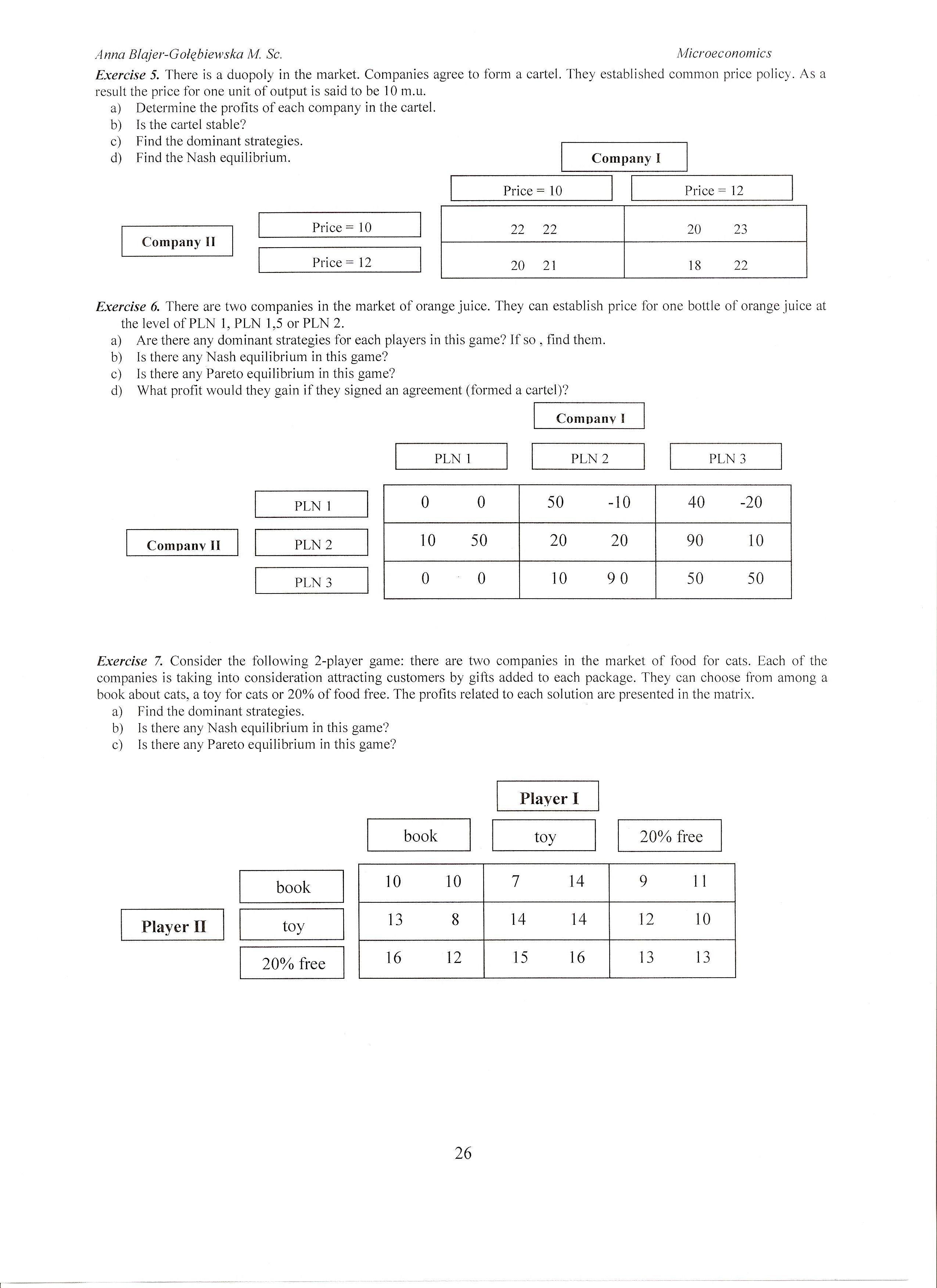skanuj0002 (76)

Anna Blajer-Gołębiewska M. Sc.
Exerci.se 5. There is a duopoly in the market. Companies agree to form a cartel. They established common price policy. As a result the price for one unit of output is said to be 10 m.u.
a) Determine the profits of each company in the cartel.
b) Is the cartel stable?
c) Find the dominant strategies.
d) Find the Nash eąuilibrium.
Microeconomics
|
Company I | ||||
|
Price =10 |
Price = 12 | |||
Price = 10
Company II
Price = 12
|
22 22 |
20 23 |
|
20 21 |
18 22 |
Exercise 6. There are two companies in the market of orange juice. They can establish price for one bottle of orange juice at the level of PLN 1, PLN 1,5 or PLN 2.
a) Are there any dominant strategies for each players in this gamę? If so , find them.
b) Is there any Nash eąuilibrium in this gamę?
c) Is there any Pareto eąuilibrium in this gamę?
d) What profit would they gain if they signed an agreement (formed a cartel)?
Company 1

|
0 |
0 |
50 |
-10 |
40 |
-20 |
|
10 |
50 |
20 |
20 |
90 |
10 |
|
0 |
0 |
10 |
90 |
50 |
50 |
|
PLN 1 |
PLN 2 |
PLN 3 |
Exerci.se 7. Consider the following 2-player gamę: there are two companies in the market of food for cats. Each of the companies is taking into consideration attracting customers by gifts added to each package. They can choose from among a book about cats, a toy for cats or 20% of food free. The profits related to each solution are presented in the matrix.
a) Find the dominant strategies.
b) Is there any Nash eąuilibrium in this gamę?
c) Is there any Pareto eąuilibrium in this gamę?
|
book |
toy |
20% free |

|
10 10 |
7 14 |
9 11 |
|
13 8 |
14 14 |
12 10 |
|
16 12 |
15 16 |
13 13 |
26
Wyszukiwarka
Podobne podstrony:
skanuj0002 Microeconomics Anna Blajer-Gołębiewska M. Sc.Exercise 8. Consumer purchases only two type
skanuj0002 Microeconomics Anna Blajer-Gołębiewska M. Sc. Exercise 4. The company produces sophistica
skanuj0003 Microeconomics Anna Blajer-Gołębiewska M. Sc. Exercise 11. Consumer’s income eąuals 12 mo
skanuj0004 Microeconomics Anna Blajer-Gołębiewska M. Sc.COSTS AND COSTS MINIMIZATION Exercise I. Div
microeconomics p18 Microeconomics Anna Blajer-Gołębiewska M. Sc. Exercise 9. On the base of profit a
skanuj0001 (69) Microeconomics Anna Blajer-Gołębiewska M. Sc.6. IMPERFECT COMPETITION AND STRATEGIC
skanuj0003 (73) Microeconomics Anna Blajer-Gotębiewska M. Sc. Exercise 8. Consider the fołlowing seą
skanuj0001 Anna Blajer-Gołębiewska M. Sc. MicroeconomicsCONSUMER BEHAVIOURExercise 1. Match the labę
microeconomics p19 Microeconomics Anna Blajer-Goiębiewska M. Sc. Exercise 13. Building contractor ‘B
skanuj0001 Anna Blajer-Goiębiewska M. Sc. Microeconomics7. MARKETS FOR FACTOR INPUTS Exercise 1. The
Anna Blajer-Gołębiewska Małgorzata ZielenkiewiczROZDZIAŁ 8TEORIA GIER JAKO NARZĘDZIE EKONOMII XX I X
86 Anna Bląjer-Golębiewska, Małgorzata Zielenkiewicz • czas podejmowania decyzji
78 Anna Blajer-Golębiewska, Małgorzata Zielenkiewicz Dynamiczny charakter zjawisk wymagał innego
80 Anna Blajer-Golębiewska, Małgorzata Zielenkiewicz własnej użyteczności z wypłat (dlatego też
więcej podobnych podstron